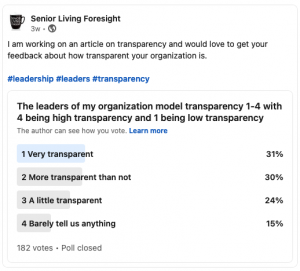By Steve Moran
The power of “I don’t know.”
A few weeks ago, I ran a poll on LinkedIn. Here are the results:

The 31% very transparent was honestly higher than I expected. But it still means that nearly 70% are not so transparent, and almost 40% have very little transparency (“a little transparent” or “barely tell us anything”).
How Are You Doing?
Take this quick quiz, and grade your transparency as a leader. Or maybe as an alternative, rank the leadership in your organization.
Rank each on a scale of 1 – 10, with 1 on the disagree side and 10 on the agree side.
- My team members pretty much know everything that is going on in my organization.
- I would rather overshare than undershare.
- I give people more than just the information they absolutely need to have.
- It is easy for me to say “I don’t know.”
- As a leader, I talk about my failures — and our failures as an organization — as a learning exercise.
- My team members feel comfortable saying to me: “I think you are wrong.”
- I trust my team members to do the right thing.
- If I lost a big contract, I would share that information with the whole organization.
- When I make a decision that is likely to have a negative impact on multiple team members, I will explain my decision.
- I have a “why,” and my team members know what it is.
Transparent Leadership
There are mountains of data that tell us that organizations with transparent leadership styles perform better. But it is reasonable to ask what transparency means and if it is possible to have too much transparency.
The second question is first. Is it possible to be over-transparent? The short answer is yes, but that is actually hard to do.
Here is what transparent leadership looks like:
- Leaders are open about the financial performance of the organization, particularly when there are challenges.
- Leaders spend a lot of time talking about what they are thinking about for the future.
- They talk about what they are struggling with and what they don’t know.
- They are open to — even love — being challenged … being told, “I think you are wrong.”
- Transparent leaders say things like, “I don’t know,” “you could be right,” “that is worth thinking about” … and mean it.
- They are more willing to take risks, try experiments, try new things.
- They are willing to course correct and then course correct again … over and over and over again.
- They don’t play favorites.
- They don’t tolerate gossip.
Finally, transparent leaders do not run free-for-all organizations, because “free-for-all” is another way of saying chaos. Transparent organizations are deliberate about what they work on, what they put on hold, and what they abandon.
How transparent are you as a leader? How transparent is your organization?








